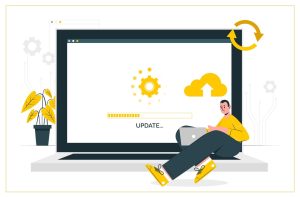The Impact Of Technology On Employee Experience

It’s difficult to deny the tremendous influence that technology has on the employee experience, take into account joining a company where cutting-edge technology has taken the place of outdated tools and procedures in an effort to empower, engage, and enhance your working experience.
Technology has changed work in a way that is comparable to bringing in a new era of work, one in which individuals participate actively in an ecosystem of innovation and efficiency rather than acting as inert cogs in a machine. Every aspect of the employment experience has been impacted by technology.
Because procedures are streamlined, communication is improved, and remote work is made easier, a more flexible and dynamic work environment is made possible.
With ongoing connectedness, the distinction between work and personal life can become hazy, and the rate of change can be intimidating.
The effect of technology, however, must be understood to be a double-edged sword that presents both opportunities and difficulties. The complicated network of technology and how it affects how we work, communicate, and thrive as workers in the digital age will be thoroughly examined in this blog article.
Technological Advancements in the Workplace
The employment experience is being transformed by technology today. Three important perspectives—the digital revolution, the rise of remote work and its technological enablers, and the smart office—can be used to understand this transition holistically.
The Digital Revolution
How we work, communicate, and interact has undergone a seismic upheaval as a result of the digital revolution. Included are several technological developments like automation, artificial intelligence, and cloud computing.
These developments have streamlined processes and provided staff with access to a wealth of informational resources, enabling them to make quicker choices and fostering a culture of lifelong learning.
The Rise of Remote Work and Its Technological Facilitators
Due to the pandemic, remote work has become more prevalent and methods and technology have had to be developed to allow for productive work to be done from anywhere.
Project management tools, video conferencing platforms, and virtual private networks (VPNs) are now necessities. Employees now have more freedom, experience less stress from commuting, and have never been able to better combine their personal and professional lives.
The Smart Office: How Technology Is Reshaping Physical Workspaces
The idea of a “Smart Office” tries to use technology to improve actual workplaces. IoT gadgets, intelligent lighting, and environmental sensors offer the greatest levels of comfort and energy efficiency.
Furthermore, cutting-edge technical innovations like conference room reservation software and hot-desking software that promote collaborative work and efficient space utilization eventually enhance the workplace. Not least, but as important, is the impact that technology has on how we work and how individuals view their occupations.
Employee Empowerment and Engagement
Technology plays a pivotal role in empowering and engaging employees like never before. Let’s take a look at these critical aspects of this transformation:
Digital Tools for Enhanced Productivity
A game-changer in increasing productivity is employee experience management software. Technology of this kind facilitates work, automates processes, and provides insightful information on worker productivity.
The goal monitoring, feedback systems, and performance analytics features of this program increase employee productivity and help them comprehend their roles within the company. This promotes a sense of accomplishment and direction.
The Role of Technology in Facilitating Employee Well-being
Technologies are interacting with the well-being of employees through wearable technologies and wellness applications. The ability to monitor one’s physical and mental health thanks to technology promotes leading better lifestyles.
A vital support network is also provided via employee assistance programs (EAPs) and mental health websites, both of which are available online. This guarantees that employees feel appreciated and cared for.
Fostering Collaboration Through Digital Platforms
Modern workplaces rely heavily on digital platforms for collaboration. With the help of team chat applications and project management tools, technology links workers wherever they may be.
As a result of the ease with which employees may engage, share ideas, and rejoice in successes, effective teamwork is fostered as well as a stronger feeling of community.
Technology generally encourages employee empowerment, businesses may foster an atmosphere where workers feel inspired, engaged, and totally immersed in their jobs by using digital technologies for productivity, well-being, and collaboration. The happiness and enjoyment of working there will gradually improve as a result.
Learning and Development in the Digital Age
The way businesses handle training and development has also been radically changed by technology, creating a dynamic and interesting work environment.
The Evolving Landscape of Corporate Training
Traditional classroom-based training is gradually giving way to more flexible and accessible digital solutions. Employees can now learn new skills and information at their own pace and convenience thanks to online learning platforms, webinars, and e-learning courses. This change lowers training expenditures while also ensuring ongoing, personalized training.
Personalized Learning Paths: How Technology Tailors Employee Development
For employers to provide employees with personalized learning opportunities, technology is crucial. There is no longer a single staff development plan that works for everyone.
To create personalized learning programs, learning management systems (LMS) and AI-driven algorithms assess a worker’s talents, areas of weakness, and career goals. Employee engagement and skill development are increased when they focus on the subjects that are most important to their employment and career objectives.
The Impact of Virtual Reality and AI on Skill Enhancement
Virtual Reality (VR) and AI have introduced immersive and experiential learning opportunities. By adopting VR simulations, employees can face real-world situations, which improves their capacity for critical thought and decision-making.
Chatbots and virtual coaches driven by artificial intelligence offer prompt guidance and feedback to promote continuing skill development, these tools link theory to practical applications, which piques students’ attention.
Challenges and Considerations
Although technology has tremendously enhanced the working environment, it has also raised a number of problems that must be resolved by organizations.
Let’s examine three important factors: Navigating the Work-Life Balance in a Digitally Connected World, The Dark Side of Technology: Addressing Burnout and Overload, and Ensuring Digital Inclusivity and Accessibility.
Navigating the Work-Life Balance in a Digitally Connected World
The constant connectivity facilitated by technology can blur the boundaries between work and personal life. Employee burnout and strained relationships may come from their inability to disengage. By encouraging employees to set limits, disconnect when required, and develop procedures that respect off-duty hours, organizations may encourage good work-life balance.
The Dark Side of Technology: Addressing Burnout and Overload
While technology enhances productivity, it can also become a double-edged sword, contributing to burn out and overload. The constant influx of emails, notifications, and the pressure to be ‘always on’ can take a toll on employees’ mental health.
To avoid burnout from happening, businesses should promote a culture that values downtime, puts digital detox plans into place, and encourages staff members to take regular breaks.
Ensuring Digital Inclusivity and Accessibility
It is crucial to make sure that all employees can access and use technology as it becomes more integrated into daily operations, businesses should invest in accessible technology and take the needs of people with disabilities into account.
In order to establish an inclusive workplace where all employees can succeed, this involves activating screen readers, providing closed captioning for movies, and making websites and applications compatible with accessibility standards.
Conclusion
The way employees connect with businesses has entirely been altered because of technology. We’ve elaborated on how technology has transformed the workplace, fostering harmony and well-being while boosting output and providing more specialized training.
But one must comprehend the challenges and concerns that come with this technological advance. A good work-life balance, the prevention of burnout, and employee engagement are necessary if technology is to be used to its maximum potential while maintaining employee welfare. Future business technology adoption must take into account any potential drawbacks.
By doing this, they will be able to design modern, efficient, inspiring, and rewarding work environments, enhancing the whole employee experience in the digital era.





